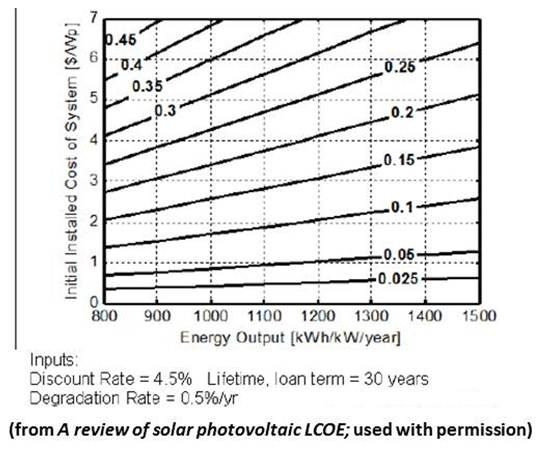Solar materials prices are down, financing is more accessible and technology has extended solar system life. The result: The price of solar energy-generated electricity, calculated by a legitimate levelized cost of energy (LCOE) method, is now competitive in many regions with the price of electricity generated by conventional sources.
To be clear, this review of solar photovoltaic LCOE is not one of those “if coal and nuclear paid for the real harm they do” analyses. It is a hard look at the actual numbers.
The study’s biggest surprise, said co-author Joshua Pearce, Materials Science and Mechanical Engineering Professor at Queen’s University and Michigan Technological University, was how much outdated information and misinformation there is about the price of residential and small/medium system solar energy. “We have reached a tipping point,” he said. “Solar has gone past grid parity.”
Parity, according to the study, is “the lifetime generation cost of the electricity from PV being comparable with the electricity prices for conventional sources on the grid.” The metric of LCOE is used “when comparing electricity generation technologies or considering grid parity for emerging technologies.”
Based on the study’s LCOE calculations, “It is still a common misconception that solar PV technology has a short life and is therefore extremely expensive.” However, he continued, “Depending on the location, the cost of solar PV has already dropped below that of conventional sources.”
For the study, Pearce and co-authors K. Branker and M.J.M. Pathak, also Materials Science and Mechanical Engineering specialists at Queen’s University, reviewed “every residential and small/medium PV solar system LCOE [calculation] that has been done,” Pearce said, identifying five key factors: “The choice of discount rate, average system price, financing method, average system lifetime and degradation of energy generation over the lifetime.”

'Discount rate' is the economist’s term for the interest rate charged on upfront costs. “The major generation cost for solar PV,” the study states, “is the upfront cost and the cost of financing.”
Discounting the future, Pearce said, is saying money “ten years from now is not worth as much as it is today,” and that makes running a coal plant seem a better investment, “even though it is going to have major operating expenses in the future” that solar won’t have.
This is especially problematic in energy economics. “The energy escalation rate can be higher than the discount rate [... because] the cost of energy over time is generally going up,” Pearce said.
Historically, Pearce said, LCOE calculations for solar have been conservative and on the high side. Given the state of knowledge of what the production of a PV system will be and what the return on the investment will be, the discount rate should be low. “As a proven technology,” the study pointed out, “solar PV should be able to obtain similar financing methods as other energy technologies, although this is not necessarily the case.”
Because it found financing so crucial, the study speculated that zero interest financing might be a more effective incentive than a feed-in tariff or a tax credit.
Previous LCOE studies' conclusions are irrelevant to today’s residential and small/medium solar systems, Pearce said, because “the cost of the panels themselves has been dropping like a rock.” This is also true, the study found, for balance of system (BOS) costs. “And maintenance costs are nothing,” Pearce added. Furthermore, he said, economies of scale in the supply chain and efficiencies coming to installation labor will bring costs down further.
Solar panel durability has also increased. Degradation of output, even for panels made in the 1980s with much older technologies, is significantly slower than the one percent rate used in previous LCOE calculations and for loan considerations.

A panel “has no moving parts; it’s all electronic and a solid-state device,” meaning that should last “a long, long time,” Pearce said. This means “we should be doing our economic analysis at least on a 30-year lifetime,” but there is not yet adequate data, he explained.
“A degradation rate of 0.2 to 0.5 percent per year,” the study reported, “is considered reasonable given the technological advances.”
“Over 90 percent of the American public is pro-solar,” Pearce said. “What holds them back is the ability to finance. But costs have dropped by more than half in the last couple of years. When you compare the average cost of a home and the average cost of the solar system, you need to provide the average electricity you need for that home -- it’s not a significant fraction.”
Pearce noted that in cost terms, the homeowner’s choice is between a solar system and other options. “Before we hit the majority of the American public, which the Department of Energy puts out only a few more years,” Pearce said, “we still need to push the economics down a little further.”
The shift to solar “is not going to happen all at once,” Pearce said. “Two pockets of the country,” he predicted, will “open up to solar first.” Solar will most quickly be noticed as competitive where electricity rates are high or where utilities have inordinate monthly charges.
Where PV becomes “economically viable,” Pearce said, will be when “the banks get comfortable with it and it becomes something that you just put on your mortgage, a normal thing that everybody in the neighborhood is doing because they can save a little every month on their utility bill.”
“It is clear PV has already obtained grid parity in specific locations,” the study concludes, “and as installed costs continue to decline, grid electricity prices continue to escalate, and industry experience increases, PV will become an increasingly economically advantageous source of electricity over expanding geographical regions.”
Here's a question: What will a tariff on Chinese solar panels resulting from the recent SolarWorld trade claim do to this hard-fought grid parity?



